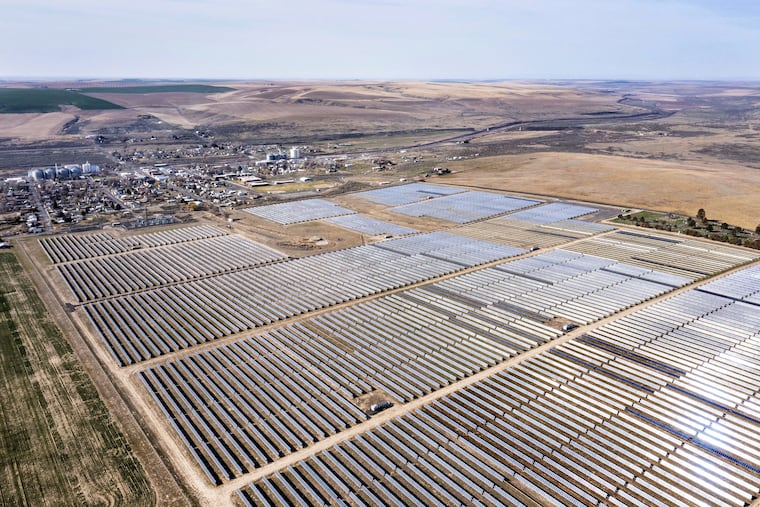Solar projects are lining up in Pa. The dos and don’ts of leasing your land.
There’s an urgent need to educate landowners before a wave of land agents with solar leases in hand come knocking, said Dan Brockett, a Penn State Extension educator.

There are now so many large solar projects planned for Pennsylvania that, if all the plans panned out, energy from the sun would finally approach output from coal and nuclear power.
More than 14 gigawatts of Pennsylvania-based utility-scale solar are in line to connect to the regional transmission grid, PJM Interconnection. But the grid’s review will take years, and many of these projects will not go forward.
Still, the queue itself is a sign of how an industry that was virtually nonexistent a few years ago is creating sparks in the Keystone state.
And that means there’s an urgent need to educate landowners before a wave of land agents with solar leases in hand come knocking, said Dan Brockett, a Penn State Extension educator.
Already, Brockett estimates more than 5,000 Pennsylvania landowners have been approached to sign option agreements. Such agreements give a solar developer between two and five years to decide whether to proceed to a decades-long land lease.
» READ MORE: Solar panel fight ends in triumph for Chester County man
The leasing flurry began about two years ago.
Solar developers were tying up land all over the place, although some areas of the state began to receive more serious consideration than others.
Today, there are more than 400 solar projects in various stages of development but only 12 utility-scale installations, totaling 195 megawatts, pumping into the grid.
That means “the facts are few here,” Brockett said.
For a utility-scale project — the average-sized project in the PJM queue is 40 megawatts — a solar developer has a checklist that begins with a landowner option agreement and ends with securing a long-term contract from a customer for the solar power the project would produce. In between, there are transmission studies, approvals from various regulators and zoning officials, environmental permits, engineering and financing.
But nothing can proceed without a piece of land, and nothing can get finalized without a customer for the solar energy, Brockett said.
Predicting which projects will proceed and which will falter is a fool’s errand, he said.
Instead, landowners should treat each offer from a solar company as if it will materialize and negotiate accordingly.
Some of the lessons learned during the shale gas land rush apply here, said Brook Duer, staff attorney at the Center for Agriculture and Shale Law at Penn State:
Never sign an offered lease as is.
Carve out pieces of your property that would be off limits to development.
Consult a lawyer.
“Few things are off limits for negotiation because ‘deal-breakers’ have not yet been established,” he said in a presentation during Penn State’s Solar Law Symposium in June.
The option agreements and leases landowners are getting now are voluminous and filled with commercial real estate boilerplate language, Duer said.
Nevertheless, “they are very straightforward legal contracts,” he said.
He’s compared it to a “commercial real estate lease on steroids.”
Duer advises while landowners are entering into a long-term business relationship, they are likely to see their business partners change several times over the course of the deal.
Property owners with shale gas leases know the drill — one company might sign the lease then sell it to another, or two companies might merge or file for bankruptcy.
Zoning fights in store
Penn State has carved out a niche in educating landowners about solar development. Last summer’s leasing webinars attracted hundreds of listeners. The more they turn to Penn State, the more information the university’s educators learn from them, too.
Brockett, for example, keeps track of how much the landowners he’s heard from are being offered to sign option agreements and leases.
“I’ve heard people sign for as low as $3,000 on the option side and as high as $50,000 for a lease,” he said.
Some solar companies have offered to buy land outright, but that is not too common — at least not yet, Brockett has found.
Most of the leases he’s seen fall between $900 and $1,200 per acre per year, with annual increases up to 2.5%.
Duer collects the legal agreements landowners send him. These are voluminous documents with legalese lifted mostly from commercial real estate leases, he said.
Meanwhile, colleague Mohamed Badissy, with Penn State Dickinson Law, is working on cataloguing more than 2,500 municipal zoning ordinances to determine which ones have specific rules for solar siting.
His preliminary results, presented at the Law Symposium in June, indicate the vast majority — 87% — either don’t mention solar or say nothing about where it can or cannot be developed.
“I feel very sympathetic for the township supervisors and zoning hearing boards,” Duer said. “They’re the ones who are going to end up feeling all the neighbor pressures and the developer pressures. All of this will be fought out in the township building.”
Typically, landowners and township officials care about setbacks, vegetative buffering, glare, liability insurance and decommissioning — that is, making sure the solar developer posts a bond to dismantle the solar equipment at the end of the lease term and reclaim the land.
Whatever people’s politics — and Brockett steers clear of those — one thing he’s learned is “there’s no perfect place to put energy projects.”
Although he’s talked to plenty of landowners over the years, “I never met anyone who really wants an energy project in their backyard.”
Anya Litvak: alitvak@post-gazette.com